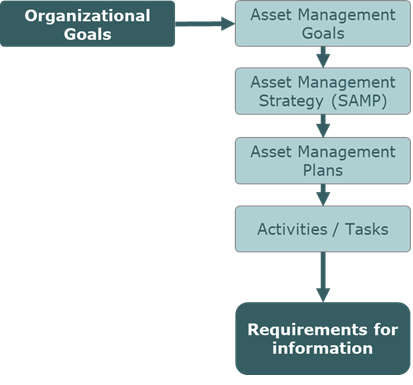
Asset Management Manual
A guide for practitioners!

Asset Management Manual
A guide for practitioners!
The most important principle of any information management in the organization is to acquire and manage data to the scope and quality required to support organizational goals. An abstract striving for the best quality of information without considering the current and planned scope of application contradicts not only the principles of modern Asset Management, but also elementary principles of economy.
When developing an information management strategy, it is therefore of fundamental importance to first identify the objectives and the resulting activities and tasks. Based on this, requirements must be defined for the information that contributes optimally to supporting these tasks and thus indirectly to achieving the company's goals (see Figure 4.3.7.3.1).

The organization's strategy for streamlined information management and the derivation of information requirements from the organization's goals, strategies, and plans are captured in the key BIM document, referred to in the ISO 19650 standard as Organizational Information Requirements (OIR).
Information about infrastructure represents a valuable asset and should be treated like other assets. The quality standard for the acquisition, evaluation and management of information should therefore be determined according to general economic principles. This involves comparing the benefits of using the information in the decision-making process with the costs of obtaining the information. The methodological basis for such consideration is provided by the discipline of Infonomics (Laney, 2017).
In this chapter, the terms "data" and "information" are often used interchangeably, although information management sees a clear difference. Data are the direct result of measurement or other survey and contain, for example, the elevation points of a roughness profile at 10cm intervals. They are often referred to as "raw data". By specific assessments, such raw data can be used to determine e.g. the IRI (International Roughness Index) for longer sections (e.g. of 100m), which are already considered as information, since these values can be used in decision-making processes. However, as long as the integration of the information into decision-making processes is hampered, e.g. because the access to the information is restricted or the form of presentation does not meet the expectations of the addressees, the benefit of such information is low or non-existent. Only when the information flows into decision-making processes and can have a positive impact on the goals of the organization will it reach the highest "evolutionary level", namely knowledge (see the so-called Knowledge Pyramid in Figure 4.3.7.3.2).

For pragmatic reasons and also because of the technical terms already established in the road sector, the term "condition data" is usually used here, even when it is clearly "condition information".